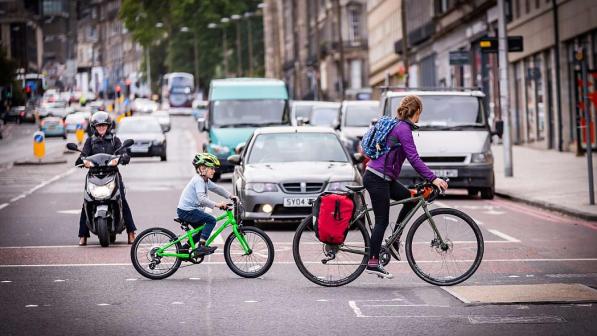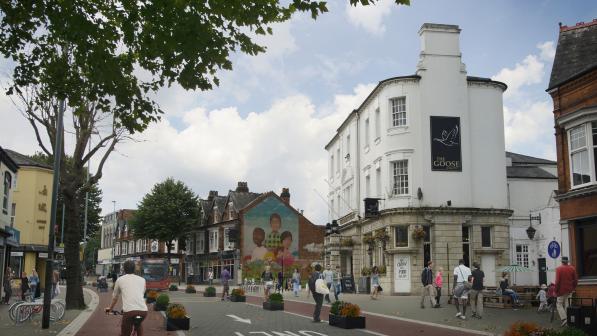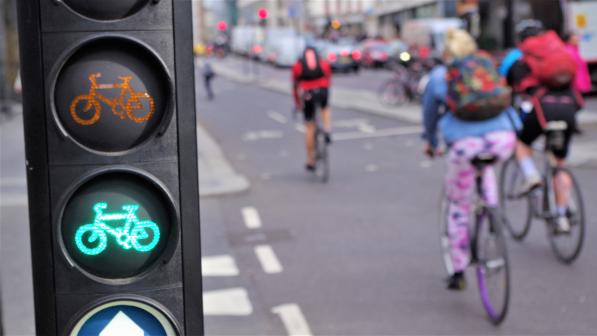Why should we have lower speed limits?

The correlation between vehicle speed and crash risk is well-documented. A report from the International Transport Forum (ITF) has echoed the findings of numerous past studies by stating:
With higher driving speeds, the number of crashes and the crash severity increase disproportionally. With lower speeds the number of crashes and the crash severity decrease.
The severity of a collision for the parties involved is, of course, largely a manifestation of the laws of physics. It follows that a cyclist or pedestrian in collision with a motor vehicle (i.e. an object of much greater mass travelling at a higher speed) is far more likely to be hurt than anyone inside the vehicle.
Another factor is how much time anyone has to react to an unexpected event like an impending collision, meaning that the faster a vehicle is going, the less time there is for the driver, or anyone in their way, to take evasive action.
This is an intimidating thought for vulnerable road users, whether they are crossing roads, or cycling or walking along them.
It is also an instinctive concern for local communities, families and schools, and it is hardly surprising that a low speed limit of 20 mph for residential streets attracts such a high degree of support amongst the British public (c70%, according to the British Social Attitudes Survey, Table ATT0359).
Cycling UK, therefore, strongly welcomes the ITF’s recommendation that the:
… forces a human body can tolerate and still survive must be considered when designing the road system and setting the speed limits. Such physical limitations are for example that most unprotected road users survive if hit by a vehicle at up to only 30 km/h …
The report also reiterates the accepted fact that even small increases make a difference:
… a 1% increase in average speed results in approximately a 2% increase in injury crash frequency, a 3% increase in severe crash frequency, and a 4% increase in fatal crash frequency. Thus, reducing speed by a few km/h can greatly reduce the risks of and severity of crashes.
Having looked at several speed-reducing schemes in ten countries, the authors recommend that:
To reduce road trauma, governments need to take actions that will reduce the speed on roads as well as speed differences between vehicles sharing the same road. For individuals, the risks of a severe crash might seem small, but from a societal point of view there are substantial safety gains from reducing mean speeds on roads.
Research on 20 mph programmes in the UK
Much research has been conducted in the UK on the impact that 20 mph programmes have had (or could have) in local areas which have already introduced schemes, or are seriously considering them. To highlight the findings of just two of them:
- Estimates published in 2017 suggest that if all current 30 mph limit roads in Wales became 20 mph limits, between 6 and 10 lives would be saved and 1,200-2,000 casualties avoided each year, at a value of prevention of £58M-£94M.
- A recent academic study reports that, in policy terms, its findings “… provide support for reducing speed limits from 30 mph to 20 mph, a process which continues in London and in cities and countries worldwide.” The data, the authors say, “… suggest that speed limits of 20 mph help reduce cycling injury risk”, (although, as they also point out, their research accounted for speed limits, not 'driven speeds', i.e. the speed at which people actually choose to drive - an important distinction).
Probably the most comprehensive study yet, though, is still expected, namely the ‘Atkins study’ commissioned by the DfT in 2014. We await this with much interest.
Cycling UK’s recommendations
Our recommendations align with those of the ITF, who (to summarise), advise:
- 30 km/h maximum (approx. 20 mph) where vulnerable road users share the same space with motor vehicles;
- Nothing above 50 km/h (approx. 30 mph) for urban areas, with the exception of limited access arterial roads where there is no interaction between motorised and non-motorised road users.
It is the case, of course, that there are some 30 mph urban streets where driven speeds are already low for some reason (i.e. below 24 mph). Consequently, implementing a 20 mph default speed limit may not make a perceptible difference.
This should not, however, be seen as an indication that such limits are ineffective. On the contrary, Cycling UK advocates the adoption of 20 mph as the default limit for most urban streets, because:
- This would give the police the unambiguous legal backing they need to intercept and, if necessary, charge the minority of drivers who persist in putting people at risk by travelling at speeds that are too high for residential environments;
- As mentioned, even small decreases in speed can reduce crash severity;
- It would help reassure communities, making their streets feel safer and improving their quality of life.
‘Default’ not ‘blanket’
It is important to stress that Cycling UK is not calling for a ‘blanket’ 20 mph approach. Rather, we believe that 30 mph (or higher) limits should be the exception (e.g. for arterial roads) and determined carefully and realistically by local authorities with input from the police and the local community.
It is these roads that would then need signing, rather than those where the default of 20 mph applies. The result would be a reduction in the total amount of signage needed, confining it to more major roads where it would be a lot less visually intrusive than on residential streets.
Implementing 20 mph
Street design and infrastructure
There are some roads where speed restrictions are not enough on their own to change behaviour.
This is most likely in streets that still look as if driving significantly above 20 mph (i.e. at 24 mph+) is still excusable, with the result that some may even breach the limit by a large margin.
Not only does this run the risk of undermining the credibility of lower limits as a concept, but makes some police forces less prepared to enforce them.
As the ITF report mentioned above states:
It is important that the drivers understand what speeds they are expected to drive at. Road design should be self-explaining, reflecting the speed limits and guiding road users in choosing the right speed.
Overall, research shows that 20 mph zones (i.e. those with traffic calming features), reduce speeds more effectively than 20 mph limits (signs only). (See the Government's advice on setting local speed limits for more on the difference).
Engineering interventions to reduce speeds, however, do not necessarily have to involve traditional traffic calming infrastructure, such as chicanes and speed humps, which are often costly and sometimes unpopular with cyclists because they can be uncomfortable and inconvenient to negotiate.
Instead, sympathetic design, high-quality (cycle-friendly) surfacing, furniture, planters and trees all help contribute to an environment where drivers are immediately given the impression that they are guests on a street and must adopt a low speed. Removing central white lines and other highway markings can also help reinforce the visual impression of a ‘street’ or a ‘lane’, rather than a road.
In other words, these measures make 20 mph streets look and feel like 20 mph streets, and provide a comfortable, safe-feeling and attractive environment for pedestrians, shoppers and people on bikes.
As pointed out above, a set limit also helps protect communities from the threat of drivers travelling too fast for the environment, because the police can then charge them with a specific offence.
Another benefit of making 20 mph the default limit for most urban streets is that they would no longer require signing, thus reducing visually intrusive clutter. On the other hand, signing would be required on roads where 30 mph (or higher) still applied.
In terms of traffic management, Cycling UK advocates restricting through movement for motor vehicles, while retaining it for cycles.
The 'installation and review' approach
Naturally, re-designing any street is not an overnight process and, for those where typical speeds are nearer 30 mph (or higher), a local authority may be best advised to exempt it from a 20 mph default until and unless it is able to introduce wider design changes to bring actual speeds down to nearer 20 mph.
Either that, or they could follow the example of Leeds City Council and adopt an ‘installation and review’ approach for the completion of its 20 mph programme. On this basis, Leeds will be monitoring compliance, and only install engineering works where regulations on their own have not brought speeds down to the acceptable level.
This will also save the council money: in the past, the average cost of each of its 20 mph zone schemes was £18,000 but, from now on, each of their forthcoming 90 schemes will come in at around £6,000 (covering legal and staff fees, and all signing).
Alternatively, where a highway authority intends, after consultation, to maintain a 30 mph (or higher) limit in the longer term, it should consider introducing high-quality protected cycle facilities as soon as possible along every exempted road.
Community engagement case study
Marks Gate in East London, a two-year collaborative project delivered by Sustrans, is a good example of positive input from the local community.
Along with a range of other interventions, trees as a gateway feature and children’s drawings on SLOW signs remind drivers that they are entering a 20 mph zone.
An interim survey found:
- 65% of the residents surveyed walked or cycled more;
- 64% felt road safety had improved;
- a 22% reduction in residents saying traffic speed is a problem;
- a 32% increase in respondents feeling the area offered space for socialising;
- a reduction in average speed on affected roads.
The more the local community is involved in the design of low speed streets, the more invested they will be in both enjoying and furthering the desired result, i.e. principally: responsible driving speeds, a safer feeling, and more local walking and cycling as opposed to driving (which in turn helps improve air quality and boosts physical activity).
40 mph for minor rural roads
Cycling UK also supports the ITF’s recommendation regarding speed limits for rural single carriageway, namely that:
- 70 km/h (c40 mph) for rural roads without ‘median barriers’ (i.e. as in rural single carriageways).
As in the case of default 20 mph for urban areas, signs should indicate any carefully considered exceptions on wider / straighter single carriageway roads, while roads with speed limits above 40 mph should progressively have cycle tracks added.
Enforcement and education
Speed limits need to be enforced actively by the police, supported by zonal cameras, Intelligent Speed Adaptation (ISA), and driver education.
The combination of good design and community engagement (as describe above) should ensure that enforcing 20 mph requires no additional police resources than 30 mph limits do.
This is important because forces are by no means always in favour of 20 mph proposals, usually because they do not feel they have the capacity to police them. Instead, they may well only support ‘self-policing’ 20 mph schemes (i.e. those implemented with traffic calming infrastructure, or which are very obviously low speed streets).
Police enforcement is a crucial factor in the success of a 20 mph scheme, although we understand that local authorities can, with the approval of their police force, institute public prosecutions of speed limit offenders (see 20’s Plenty briefing for more).
Technology
Early cameras were criticised on the grounds that they prompted drivers to slow down momentarily (and possibly unsafely), then speed up immediately afterwards. Zonal cameras, which calculate the average speeds of vehicles over a measured distance travelled within the enforcement zone, give an accurate idea of a driver’s behaviour throughout a speed limited area, and make this kind of response entirely pointless.
Now that speed cameras can measure speed very precisely, including those operated by police on-site, Cycling UK does not believe there should be any margin of tolerance. As is often said, a speed limit is the maximum, not a target.
Cycling UK is also in favour of Intelligent Speed Adaptation (ISA), i.e. using technology to ensure that vehicles stick to the defined speed limits. Estimates suggest that such a system could eliminate 20% of injury collisions and 37% of fatal collisions.
Education
Education is an essential adjunct to any enforcement regime, and the effectiveness of 20 mph schemes is as reliant on the combination as any other measure to improve road safety.
Again, good community engagement is a key component here too.
Pollution
With the UK struggling to meet its legal limits on air pollution, especially in urban areas, there are understandable concerns about the effect lower speeds have on air quality. This is a complex issue, with the mix of traffic, fuel type (i.e. diesel or petrol), age of vehicles, driving styles, the presence or absence of calming infrastructure, junctions and pedestrian facilities (i.e. features that lead to deceleration/acceleration) etc. all coming into play.
It is Cycling UK’s understanding, however, that it is most unlikely that 20 mph limits impact negatively on air quality.
As a project report (2013) for the City of London concluded after a full technical analysis of the environmental impacts of 20 mph restrictions in central London: “… it would be incorrect to assume a 20 mph speed restriction would be detrimental to ambient local air quality, as the effects on vehicle emissions are mixed”.
It seems that in many residential streets with existing 30 mph limits, speeds are close to 20 mph in any case. Consequently, lowering the limit will make little difference (although we argue, of course, that it does make a positive difference to enforcement, perceptions of safety and comfort, and the attractiveness of non-polluting modes over driving).
The study also found that, when light-duty petrol vehicles travel at 20 mph speeds, the emissions are not greatly different to when they travel at 30 mph (per g/km: +7.9% for NOx; +2.1% for CO2). For diesel vehicles, on the other hand, the difference was large (per g/km: -8.2% for NOx; -0.9% for CO2). Importantly, both fuels showed -8.3% g/km for PM10 (particulate matter).
It seems, in fact, that 20 mph is particularly valuable in terms of reducing particulates.
The academic study of the potential impact of 20 mph in Wales referred to above concluded that if all current 30 mph limit roads there become 20 mph limits: “In terms of air pollution, deaths attributed to nitrogen dioxide (NO2) may increase by 63, and years of life lost by 753. However, deaths attributed to particulates (PM2.5) may decrease by 117 and years of life lost by 1400.”
(The review also highlighted other benefits in terms of road traffic casualties, active travel, noise pollution, greater social inclusion, greater community cohesion and local business viability).
It goes without saying, though, that if lower speeds make walking and cycling more attractive than driving for local journeys, there will be fewer cars on the roads to pollute the air anyway.
With regard specifically to cyclists, who usually ride in close proximity to motor traffic in urban areas, assessments of the overall health impacts of cycling have consistently concluded that the benefits outweigh the disbenefits. Not all assessments have factored in traffic pollution, but even those that have still suggest that cycling as a physical activity is far more beneficial than harmful to health. For more, see our briefing on air quality.


